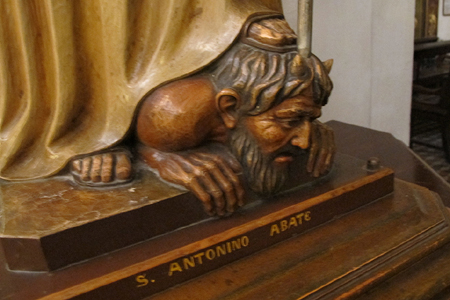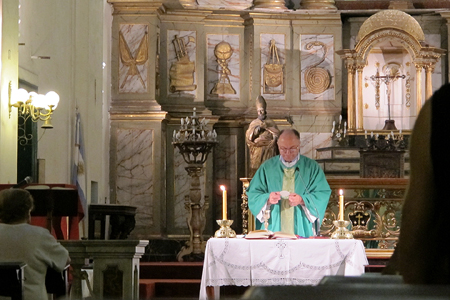| |
 |
 |
 |
| Comment on this report, or find other reports. |
 |
| Our Mystery Worshippers are volunteers who warm church pews for us around the world. If you'd like to become a Mystery Worshipper, start here. |
 |
| Find out how to reproduce this report in your church magazine or website. |
|
|
| 2533: San Pedro
González Telmo, San Telmo, Buenos Aires, Argentina |
 |
 |
 |
Mystery Worshipper:
Augustine the Aleut.
The church:
San Pedro González Telmo, San Telmo, Buenos Aires, Argentina.
Denomination: Roman
Catholic, Archdiocese
of Buenos Aires.
The building: Originally
a Jesuit church, Nuestra Señora de Belen, the church
was given to the Order of Our Lady of Bethlehem, more commonly
known as the Bethlehemites, after the suppression of the Jesuits
in 1773 (restored by Pope Pius VII in 1814). (The Bethlehemites
themselves were suppressed in 1820 but restored by Pope John
Paul II in 1984.) The church was built in 1746 but the dome
was not finished until 1858 and the twin towers in 1876. It
has a lot of the colonial baroque about it, but is bright and
not overwhelmed by cascading gilt. Two founders of Argentinaís
independence left their traces here: General Manuel Belgrano,
who donated the pulpit, and Governor Juan Manuel de Rosas, who
donated the altar. The school across the street was one of the
first in the city and was later the first medical school in
Argentina; in recent years it has returned to its initial incarnation
as an elementary school. The Jesuitsí nearby retreat house and
domestic chapel is now the Argentine Penitentiary Museum.
The church: There
are a number of youth programmes there to keep kids occupied
after school before their parents return from work.
The neighbourhood: San
Telmo is a gritty Bohemian neighbourhood, home to three small
universities, lots of antique shops, and many historic houses
gradually being redeemed from crumbling by gentrifying Argentines
and foreigners. The church is a few hundred metres from La Defensa,
the street so named as its rowdy inhabitants fought British
troops advancing in from the harbour in 1807. The locals are
still rowdy and they likely could still repel a new British
invasion. The sidewalks and the cobbles are probably from that
period and havenít been repaired since. Around the corner and
across the street, one finds oneself on the site of a former
interrogation centre from the Dirty War of the mid 20th century.
The cast: There
was no notice or announcement, and there is no parish website.
The presider was in his fifties, and was assisted by a young
deacon.
The date & time: Thursday,
February 7, 2013, 6.30pm. [Editor's note: This report was filed
April 24, 2013.]
What was the name of the service?
Parish Mass.
How full was the building?
We could likely squeeze in 300. There were 35 present, of a
wide range of ages, and almost as many men as women. People
were generally respectably dressed, although perhaps half a
dozen had just come in from labouring jobs.
Did anyone welcome you personally?
I received curious but not inhospitable looks from parishioners,
who could see that I was an outsider. Three or four nodded at
me and another parishioner greeted me with a touch on the shoulder
as he entered and passed by my pew.
Was your pew comfortable?
It was a little narrow, but the pews had been spaced decently from each other, so I was not cramped. I was seated near a statue of St Anthony the Abbot, with his foot planted on the devilís head – this saint is the patron of a country and western music festival in western Québec so I have always had a sneaking admiration for him.

How would you describe the pre-service
atmosphere?
The church was quiet and cool, far from the vehicular noise
and fumes, and the heat of the day (32°C that afternoon).
What were the exact opening words of the
service?
"En el nombre del Padre, y del Hijo, y del Espiritu
Santo."
What books did the congregation use during the
service?
There were no service books; the people followed the service
by memory.
What musical instruments were played?
There were no instruments aside from the organ, but we had an
a cappella hymn during the communion.
Did anything distract
you?
Every few minutes, another worshipper would go over to the statue
of San Cayetano (patron saint of job seekers and of good luck)
and light a candle – there was a veritable stream of them.
Was the worship stiff-upper-lip,
happy clappy, or what?
The service was very Buenos Aires, friendly and moving along
snappily. Everyone seemed quite relaxed.

Exactly how long was the sermon?
10 minutes.
On a scale of 1-10, how good was the preacher?
8 – I score him by judging the reaction of parishioners
– this was the first of many times when I realized that
I couldn't understand a word of Argentine Spanish.
In a nutshell, what was the sermon
about?
I havenít a clue. While I can understand the Castilian of Spain,
the local variation (porteño) is twice as fast,
full of local turns of phrase, and heavily Italian in its intonation.
Assume you had learned English in Scotland, and then been sent
to Brooklyn; or had learned French in Touraine and then ended
up in the east end of Montreal.
Which part of the service was like being in
heaven?
The friendliness of parishioners to a foreigner in their midst.
And which part was like being in... er... the other place?
My inability to understand a word – I could barely follow
the Lordís Prayer, only recognizing it part way through.
What happened when you
hung around after the service looking lost?
Not much. I took a picture or two and then left as the lights
were being doused. But a day or so later, heading off to my
regular café for an after-dinner drink and to watch the
incredible parade of characters stroll up and down Calle
Estados Unidos, my dashingly tattooed waitress identified
me from the church, saying that she had never seen a tourist
there before.
How would you describe
the after-service coffee?
No after-service coffee, but a few steps away, a plate of the
exquisite beef of Argentina awaited me, to be washed down with
a decent Mendoza.
How would you feel about making this church your regular (where 10 = ecstatic, 0 = terminal)?
7 – This would be my neighbourhood church if I stayed in
Argentina. People were friendly, so I would likely give it a
7 or 8.
Did the service make you feel glad to be a
Christian?
As in many other places in this country, I appreciated the quiet friendliness of parishioners to this stranger among them.
What one thing will you
remember about all this in seven days' time?
The steady stream of parishioners heading to the statue of San
Cayetano. He is a favourite saint of poor people in Buenos Aires
– on the 7th of every month, petitioners ask for his intercession
por pan y trabajo (for bread and work), but you must
never ask for yourself, only for another. The waitress who had
recognised me told me that everyone knew of somebody who needed
work and that they kept the saint busy Ė she hoped he belonged
to a union! |
|
|
 |
 |
 |
| We rely on voluntary donations to stay online. If you're a regular visitor to Ship of Fools, please consider supporting us. |
 |
 |
 |
| The Mystery Pilgrim |
 |
| One of our most seasoned reporters makes the Camino pilgrimage to Santiago de Compostela in Spain. Read here. |
 |
 |
 |
| London churches |
 |
| Read reports from 70 London churches, visited by a small army of Mystery Worshippers on one single Sunday. Read here. |
| |
|
|
|
|


